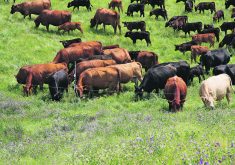Farming is the backbone of the prairie provinces. The economic spinoff is immense. Bio-technology, manufacturing companies, equipment dealerships, chemical, fertilizer and grain companies, governments and many others all rely on a strong agriculture economy so that they can have their piece of the pie. …
We have been overtaxed, lost the Crow rate and programs like GRIP. Input and machinery costs have skyrocketed. Rail-line abandonment and elevator closures are now a reality. Communities are disappearing. The distance that we have to haul our commodities and the cost of getting there is increasing drastically.
Read Also

Invigor Gold variety viewed as threat to condiment mustard
Invigor Gold, the canola-quality mustard developed by BASF, is on a collision course with Canada’s condiment mustard industry. It’s difficult to see how the two can co-exist.
It all ends up with less money in our pockets. Where is it going to end? With the loss of the family farms.
Federal and provincial governments make millions every year by biting the hand that feeds them through taxes levied on products we initially produce.
Take a look at what our products help to produce in revenue to our governments.
One bushel of malt barley ($2.15 farm price) makes 333 12-oz. bottles of beer
A dozen beer sell for $17.50; 333 bottles is $485.63 from one bushel of barley.
At 50 bushels/acre, 160 acres equals sales of $3,885,040.
Taxes on one case of beer include: provincial tax, $4.55; federal tax $1.15; GST $0.75; Liquor Consumption Tax $0.75. Total taxes: $7.20, or $0.60 tax per bottle. For 333 bottles, $199.80 tax is received from our one bushel of barley.
One quarter section of land (160 acres) producing 50 bushels/acre of two-row malt barley would equate to $1,598,400 tax revenue for our governments. …
What does the farmer get out of this? 50 bushels/acre at $2.15 is $107.50 /acre.
Expenses per acre: seed $6.50, fertilizer $18, chemical $20, fungicides $16, fuel/repairs $15, crop insurance $4, school tax $3.75, municipal tax $2.50, insurance $1.60, machinery/land investment cost $31.50.
Labor – what labor? It’s free. After all, we only work four weeks in a year, according to some people.
Total expenses $118.85/acre, total income $107.50/acre, leaves a net income (loss) of ($10.75/acre). …
One quarter section of land (160 acres) producing 30 bu./acre of rye would equate to $11,995,200 tax revenue for our governments. …
It doesn’t matter what our total income is, be it from farming, investments, inheritance or off-farm income. Without making a fair return per acre it is only a matter of time before our farms are gone.
Any business that operates at a loss year after year will not be around in the future. The smaller farms and inefficient farmers were gone years ago.
We are asking to be paid a fair price for the valuable commodity that we produce. We cannot continue to produce food for below cost. We are not asking for a handout or a bailout, just what should be ours in the first place. A decent return for our investment and labor.
Together we can all make a difference to keep the family farm alive.
– Bob Turner,
Cupar, Sask.














